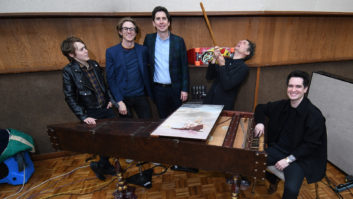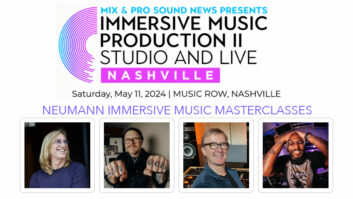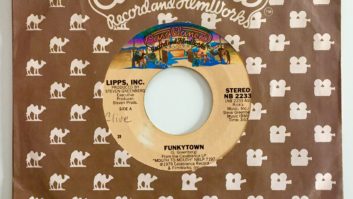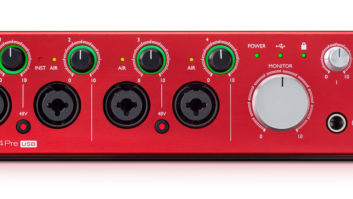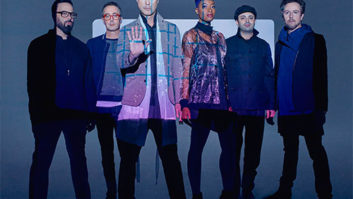
While working on the latest Panic! At The Disco album, Death of a Bachelor, producer Jake Sinclair ended up in the psych ward. This occurrence wasn’t strictly the fault of Brendon Urie, the sole remaining—and always central—member of Panic! At the Disco. Sinclair, who honed his chops engineering for Butch Walker for a number of years, and in the process became an in-demand producer in his own right (Fall Out Boy, Weezer), took on too many projects at the same time, ending up in a much-needed breakdown. Rescued by his engineer Suzy Shinn, Sinclair now sits in his very comfortable studio, a spacious room at Infrasonic Studios/Vintage King complex in Los Angeles’ Echo Park neighborhood, and he could not be more jovial and relaxed. Sinclair makes sure to take weekends off, and the youthful producer is in bed by 10 p.m.
Sinclair’s relationship with Urie goes beyond professional. As the engineer on the hugely successful modern-rock act’s last two albums Too Weird To Live, Too Rare To Die and Vices & Virtues, the two have developed both a close friendship and a working shorthand over the past six years. Sinclair made a number of good decisions for Urie: to set up his own, fully functioning home studio, to separate the songwriting from the production process, and to reformat Panic!’s sound—which, granted, changes with every album.
To this end, Sinclair put together a studio for Urie that mirrors his own as closely as possible, particularly in the vocal chain. This includes a Wunder Audio CM7 that in Urie’s studio goes through an Undertone Audio MPDI-4 mic-pre into a UAD Apollo. At Sinclair’s, the CM7 goes through BAE 1073, then into a Purple Audio MC77 limiter and Universal Audio LA-2A. The idea being, if there is anything exceptional captured on the demos, it can be used in the final version of the song. Urie can turn on the magic at any point in time, confirms Shinn, whose special area of expertise is vocals. Sinclair likens him to a Broadway singer, stating that the last take can be the final one, with no comps and tuning.

“The Beatles’ recordings are what I’m about vocally,” Sinclair says. “The vocal sits in a certain pocket in the midrange that’s very translatable. With a big voice, it’s always a good choice. When the voice has a lot of character [like Urie’s], it doesn’t sound good doubled. It’s better to get everything else out of the way and turn that one thing up. You have less data in the way and there’s nothing to hide behind. You can see the up-close shot of the person.”
Before getting to this point, however, Sinclair and Urie spent a long stretch of time focused strictly on songwriting. Both melody-driven rather than lyricists, they made words their starting point. Writing themselves, as well as getting input from lyricists such as Morgan Kibby, Sam Hollander, and Lolo, among others, they thought of the lyrics as building blocks for the melodies. Recording voice memos with just a piano and vocals, the two would send it to their manager, whom they share, and go forward based on approval. The album was already picked out before it hit demo stage.
“I would have [Urie] start the demo with direction from me,” Sinclair says. “I would then let him finish at home. He’s very capable in Logic—more so than he gives himself credit for—so he did most of the programming and synths and sampling. It was a matter of completing whatever vision we started with at his place. He would send me files and I would reorganize what he did and replace sounds in Pro Tools.”
A Frank Sinatra-style crooning—a sharp turn from the bright shouts of modern rock—proved an unexpected direction. Urie ably tackles the croons on the title track and the closer, “Impossible Year.” The former, if the smooth vocals are removed, is essentially a hip-hop track with an 808-generated bass sound, plus programmed and sampled drums in Logic and Pro Tools. The latter, on which Urie starts low and changes key on each verse, features only piano, bass and horns, once again withholding over-instrumentation.
In contrast, Sinclair incorporated Urie’s love of hip-hop and his constant spitting of rhymes into the songwriting. Using a hip-hop track at the core of the song, the two wrote over the top with organic instruments, adding big-band horns—recorded by Rob Mathes at Avatar Studios in New York City—to every song. Says Sinclair, “A horn section adds an air you don’t get with Arturia synths or samples. It was a way of taking some of the melodic ideas that we had and giving them an extra layer you can’t get any other way.”

Urie’s noted multi-instrumentalism comes into good play on Death of a Bachelor. Once past the songwriting and demoing, the tracking happens in Sinclair’s studio to Pro Tools. Here Urie is put to work on every instrument. A vintage Ludwig four-piece drum kit with an AEA R88 microphone on the overhead and an AEA R44cx for the room, both smashed to bits with a Chandler TG1 limiter. Sennheiser MD421 II on the toms, AKG D12 on the kick, Josephson e22S on the snare, and AKG D190 on the snare shell. All go through BAE 1073MP with the snare shell additionally smashed with a dbx 165a compressor, attempting to re-create a Tame Impala-like exploding drum sound.
A Guild Starfire hollow body bass with flatwounds is used going through an Ampeg B-15 bass amp. The chain is not dissimilar to the vocals with a CM7 FET microphone through a BAE 1066 and Purple MC77. A Duesenberg guitar is used through a 1972 Mesa Mark amp—the only one Sinclair finds acceptable. (“It has this midrange crunch that just jumps out of the speakers.”) The Road King 4×12 cabinet is miked using Josephson E22S and Royer R-121 placed side by side where the cone meets the paper. This goes through Sinclair’s favorite preamp, Chandler TG2, summed to one track.
“[Urie] is the best instrumentalist at every instrument—anything he picks up sounds great,” says Sinclair, who readily admits his jealousy of Urie’s capabilities. “He’s such a talent, such a force, but he’s such a nice guy, always trying to please and keep everyone happy. If he is allowed to let loose, it’s incredible. I felt like I was almost trying to trick him into being himself. I don’t think [Urie] is trying to be pop; he is a pop star.”
